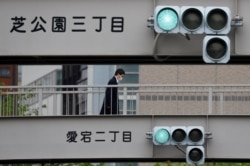Italy began to relax its coronavirus lockdown on Monday as more U.S. states also started easing restrictions to allow economic activity to resume.
More than four million Italians were allowed to return to work Monday, following the longest lockdown in Europe. Factory and construction workers resumed their jobs while all residents were allowed to again take walks and visit relatives. Restaurants were able to provide take-away service for the first time since the lockdown began.
The country has confirmed around 212,000 cases of coronavirus and about 29,000 deaths. Health officials reported 195 new deaths Monday, well down from the peak of over 900 daily fatalities at the end of March.
In the United States, Ohio is allowing manufacturing to resume, Louisiana is sending lawmakers back to work, and Florida is reopening more of its beaches. In the capital, Washington, the Senate is convening for the first time since March.
In Spain, commuters using public transportation were required to wear masks Monday, as more coronavirus lockdowns were eased, while health officials reported 164 new deaths.
Six million masks were available for free distribution at various stations of the public transport systems in Madrid, Barcelona, Mallorca, Valencia and other cities.
Businesses also started reopening in parts of Malaysia as Prime Minister Muhyiddin Yassin eased lockdown restrictions originally set to expire May 12.
Yassin's government is one of many across the globe considering how to balance measures meant to stop the coronavirus from spreading against the desire to restart economic activity.
Lebanon allowed restaurants to reopen but only at 30% of capacity and South Africa allowed trains, buses and taxis to resume operations while also limiting capacity.
No new cases in New Zealand
In New Zealand, health officials reported zero new coronavirus cases Monday for the first time since the middle of March.
The milestone comes a week after the country began loosening strict lockdown rules imposed a month ago to stop the spread of the virus.
"Clearly these are encouraging figures today, but it is just one moment in time," said Director-General of Health Ashley Bloomfield.
"The real test is later this week when we factor in the incubation period for the virus and the time it takes for people to display symptoms, which is generally five to six days after exposure," Bloomfield added.
While New Zealand has made significant progress against the virus with about 1,500 total confirmed cases and 20 deaths, it is taking a cautious approach to reversing stay-at-home measures. Most schools are still closed, as are most shops and restaurants.
Health officials: Not so fast
Health officials around the world have cautioned against reopening too quickly and risking a new wave of infections that would reverse progress made in recent weeks in areas under lockdown.
The virus has strained health care systems and forced governments to take novel approaches to increasing capacity to care for patients.
In Mexico City, officials are converting areas of the Formula One racetrack into medical bays with about 200 beds along with facilities for consultations with people who are reporting COVID-19 symptoms.
Japanese Prime Minister Shinzo Abe announced his government is extending Japan's state of emergency through the end of the month.
The restrictions were due to expire Wednesday in a country that has reported about 15,000 infections and 500 deaths.
Meanwhile, the number of confirmed cases rose quickly again in Russia, which on Monday reported its second consecutive day with more than 10,000 new cases. That puts it at more than 145,000 total with 1,350 deaths.
The World Health Organization (WHO) urged global unity Monday to counter the virus.
"This virus will be with us for a long time and we must come together to develop and share the tools to defeat it," WHO Director-General Tedros Adhanom Ghebreyesus told reporters at a virtual briefing in Geneva.
A major focus for dealing with COVID-19 is the search for a vaccine, which the WHO says currently involves about 90 different potential formulations in several countries.
Those vaccines must be tested both for safety and to prove they are effective before doses can be manufactured for the public. Health officials have cautioned the process could take 12 to 18 months.
But U.S. President Donald Trump was more optimistic Sunday, saying he thinks there will be a vaccine by the end of this year.
There are more than 3.5 million confirmed cases of COVID-19 worldwide, with nearly 250,000 deaths.












